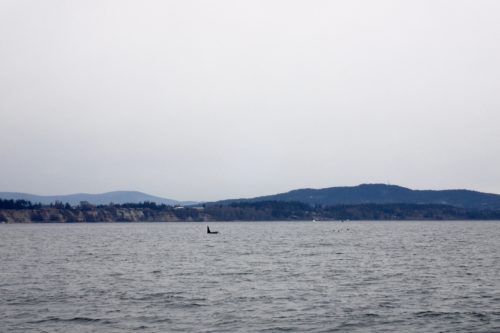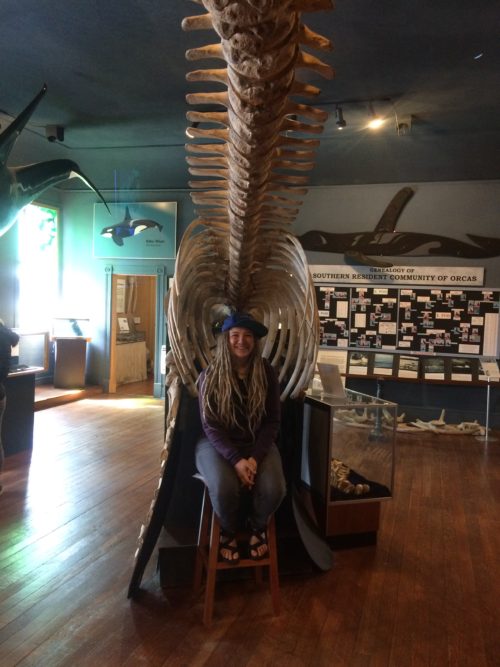
In Search of the Southern Residents: Researching Orcas’ Natural History
Why Orcas
Growing up, I have always been fascinated with whales. Orca, humpback, sperm, blue, narwhal… you name it! I have quite the collection of whale books on my shelves, some whale toys and other relics. I even have a large tattoo of a humpback whale. But when I moved out to the North Cascades for graduate school, I hadn’t realized I was moving toward these majestic creatures and my first wild orca encounter, potentially opening up a door for future research and educational work with marine life.
In January, I attended the Storming the Sound conference in La Conner, Washington. It was a small regional event with a strong marine theme, located on the shore of the Salish Sea. It blew my mind to think that I had driven less than two hours down the Skagit Valley, just below the Cascade crest, and I was now in a completely different ecosystem, yet still connected to the rugged, steep mountains. The last session of the conference was Howard Garrett, co-founder of Orca Network, presenting on the Southern Resident orcas and their intertwined fate with Chinook salmon. I sat engaged, listening to Howard speak about his lifetime of research on the orcas and how it is so close geographically to me. I was emotionally compelled by his presentation and taken aback by the current status of the Southern Resident population.
Active Research
After my experience at Storming the Sound and upon my selection of this natural history topic, I did the first thing any whale fanatic living in close proximity to marine life would do, I signed up to go whale watching! During spring break, I embarked on a five-hour wildlife search on a commercial whale watching tour. Ideally, this would have played out as a sea kayaking trip or small watercraft, something more intimate on shore, but for my time and resources, this was the perfect opportunity for me. Despite being on the mend from the flu, I donned my binoculars and rain gear, keeping my camera, field notebook, and tea in my hand to board a 70-person or so capacity boat with my husband.

Notebook in hand, ready to see some wildlife! Photo courtesy of Rachael Grasso
Leaving from Anacortes, the trip was one of the first of the season for Island Adventures, a whale watching tour company. Our captain was chatting over the loudspeaker while the tour guide, Brooke, was checking the tickets of boarding passengers. Once the boat left the dock, a bald eagle immediately flew by, graceful as ever. To me, this was a positive sign that the day was going to be filled with wildlife. Nevertheless, I did not want to peak with excitement then crash into disappointment if we were out for the day and didn’t see any whales. So I remained calm, keeping my eyes focused on the shoreline.
About an hour into the trip, there was word that a humpback was spotted near Canada, and we immediately headed northwest. En route, there were other boats that reported seeing orcas off of Vancouver Island. We found the collection of boats, and low and behold, the captain called all passengers to the left side of the ship.

Transient T11A surfacing between dives. Photo courtesy of Rachael Grasso
The tall and prominent dorsal fin of an adult transient male (T11A) and a smaller one of his mother (T11) cut through the water’s surface. This was it! I was in complete awe at my first experience seeing orcas in the wild. Even if we only saw their dorsal fins break the surface between dives; words cannot describe the overwhelming feeling I had to see these large apex predators with my own eyes.

Rachael’s field notes from a day of whale watching. Photo courtesy of Rachael Grasso
Back on land, I was eager to learn more about orcas. After reading numerous articles and books, I felt as if there was still so much more to discover about the largest member of the dolphin family. From my research, I learned of the Whale Museum, just a ferry ride away from familiar Anacortes in Friday Harbor on San Juan Island. On an early weekend in May, my husband and I, again with binoculars, cameras, tea and field notebooks in hand, embarked on the Elwha Ferry towards the Whale Museum.
A small, two-story building with orcas painted on its exterior walls, the Whale Museum can be spotted from the harbor. Exhibits fill the second floor, packed with information about whales and other marine mammals. The museum largely focuses on orcas, specifically the Salish Sea’s Southern Resident population, and supports ongoing orca research in the area. I am happy I made the trip!

Rachael sitting inside an orca skeleton at the Whale Museum! Photo courtesy of Rachael Grasso
To discover more of the Southern Resident orcas’ natural history and their connection to the Cascades through chinook salmon, read Rachael’s full natural history project here.
Rachael is a graduate student at North Cascades Institute. Originally from Pennsylvania, Rachael seeks to combine her love for mountains, rivers and wildlife through environmental and outdoor education in the Pacific Northwest.

